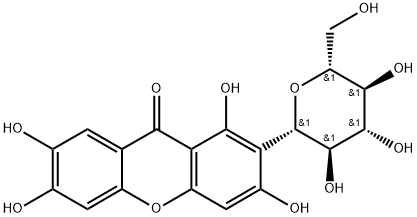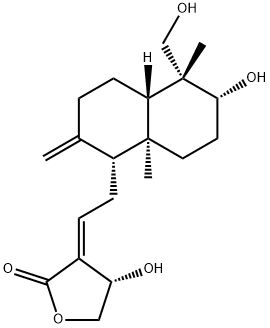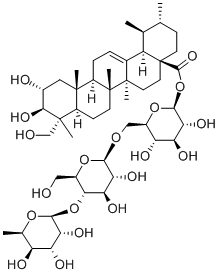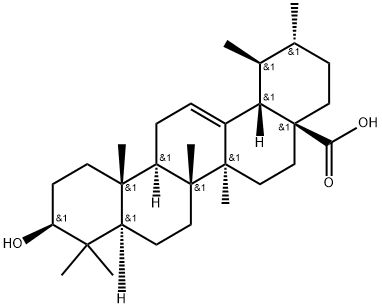Mangiferin , 10mMinDMSO , 4773-96-0
Synonym(s):
1,3,6,7-Tetrahydroxyxanthone C2-β-D -glucoside;Chinomin;Chinonin;Shamimin
CAS NO.:4773-96-0
Empirical Formula: C19H18O11
Molecular Weight: 422.34
MDL number: MFCD00075656
EINECS: 624-757-7
| Pack Size | Price | Stock | Quantity |
| 1ml | RMB159.20 | In Stock |
|
| others | Enquire |
PRODUCT Properties
| Melting point: | 269-270°C |
| storage temp. | 2-8°C |
| solubility | DMSO (Slightly, Sonicated), Methanol (Slightly), Pyridine (Slightly, Heated) |
| Boiling point: | 842.7±65.0 °C(Predicted) |
| Density | 1.843±0.06 g/cm3(Predicted) |
| pka | 6.09±0.20(Predicted) |
| form | Solid |
| color | Pale Yellow |
| Stability: | Hygroscopic |
| InChIKey | AEDDIBAIWPIIBD-AZBPZEDSNA-N |
| SMILES | OC1=C([C@H]2[C@@H]([C@@H](O)[C@H](O)[C@@H](CO)O2)O)C(O)=CC2OC3=CC(O)=C(O)C=C3C(=O)C1=2 |&1:3,4,5,7,9,r| |
| LogP | 0.130 (est) |
| CAS DataBase Reference | 4773-96-0(CAS DataBase Reference) |
Description and Uses
Mangiferin is a plant natural polyphenol of C-glycosylxanthone structure and various pharmacological activities. It can be found in many plant species, among which the mango tree (Mangifera indica) is one of the primary sources. Mangiferin is also present in some medicinal herbs, influencing their therapeutic and preventive properties, and in honeybush (Cyclopia sp.), a popular South African herbal tea. Mangiferin dissolves well in water, so it can be easily extracted into infusions and decoctions. In the mangiferin molecule, four aromatic hydroxyl groups determine its strong antiradical and antioxidant properties. Mangiferin is also an efficient iron chelator, therefore preventing the generation of hydroxyl radicals in Fenton-type reactions[1].
MAO inhibitor, immunostimulant
Safety
| Symbol(GHS) |  GHS06 |
| Signal word | Danger |
| Hazard statements | H300 |
| Precautionary statements | P264-P270-P301+P310-P405-P501 |
| Hazard Codes | T+,Xi,Xn |
| Risk Statements | 28-36/37/38-22 |
| Safety Statements | 22-28-36/37-45-36-26-24/25 |
| RIDADR | UN 3462 6.1/PG 1 |
| WGK Germany | 3 |
| RTECS | OP1927800 |
| HS Code | 29389090 |




